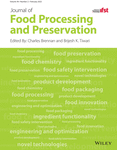Effects of slightly acidic electrolyzed water pretreatment combined with compound bio-preservatives on quality and microbiota changes of refrigerated obscure pufferfish (Takifugu obscurus)
Abstract
The evaluation of ε-polylysine hydrochloride (PLH) and rosemary extract (RE) combined with slightly acidic electrolyzed water (SAEW) on the quality and microbiota changes of obscure pufferfish (Takifugu obscurus) was studied during refrigerated storage at 4 ± 1°C. The fish samples were first impregnated with SAEW and then dissolved in sterile water (CK) and different solutions (0.2% RE, 0.3% PLH, 0.2% RE+0.3% PLH (RP)). Changes in microbiological indicators (total viable counts [TVC], psychrophilic bacteria counts [PBC], pseudomonas bacteria counts, H2S-producing bacteria counts) and physiochemical indexes (ATP-related compounds, K value, total volatile basic nitrogen [TVB-N], and biogenic amines content) were also examined, the microbial composition of the samples was analyzed using high-throughput sequencing. Results showed that PLH treatment had the lower microbial counts and TVB-N. The degradation of inosine monophosphate (IMP), the production of hypoxanthine riboside (HxR) and hypoxanthine (Hx) in treated groups were slower than that of CK group. Moreover, RP group effectively delayed the production of biogenic amines. Illumina-MiSeq high throughput sequencing results demonstrated that the microbiota of each group became less diverse during storage, and Janthinobacterium in treated groups increased significantly. Pseudomonas became the major predominant microbiota of obscure pufferfish (Takifugu obscurus) at the end of storage. According to the results of TVC, SAEW combined with RP could prolong the shelf-life of obscure pufferfish for another 6 days.
Practical applications
Obscure pufferfish (Takifugu obscurus) is enthusiastically welcome due to the palatability and nutritional value of its flesh. However, it is vulnerable to spoilage caused by microbial growth and metabolisms. Based on the results of microbiological analysis total viable counts, compared with CK group, samples with compound bio-preservatives treatment maintained good quality and prolonged the shelf life of obscure pufferfish for another 6 days.
CONFLICT OF INTEREST
The author declares that there is no conflict of interest that could be perceived as prejudicing the impartiality of the research reported.
Open Research
DATA AVAILABILITY STATEMENT
Data openly available in a public repository that issues datasets with DOIs.




